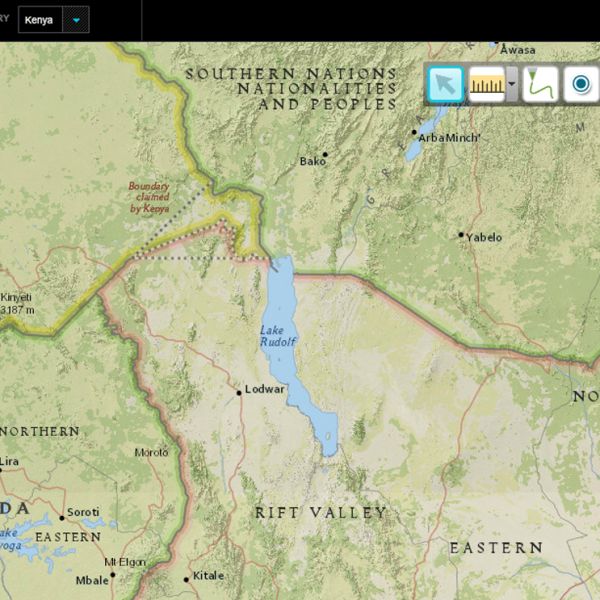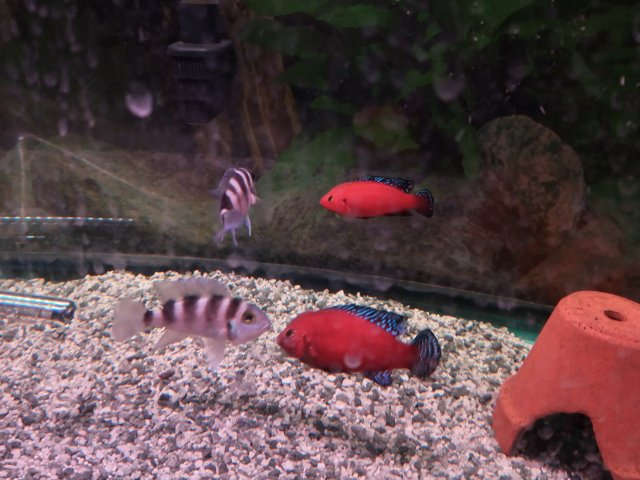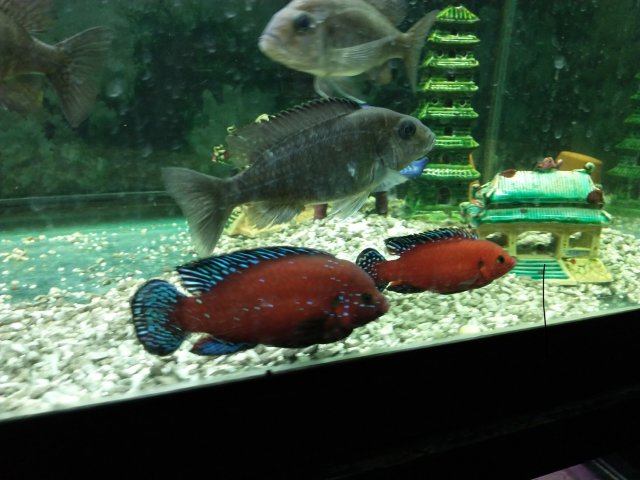Lake Turkana Jewel Cichlid
- Thread starter tiger15
- Start date
You are using an out of date browser. It may not display this or other websites correctly.
You should upgrade or use an alternative browser.
You should upgrade or use an alternative browser.
They are one of the more peaceful jewel cichlid. Males don't engage in gladiator fight during breeding time as other jewel cichlid if you provide them with enough room. I don't keep any Mbuna which will likely overpower them. They get along with peacock and other mild temper cichlid, but they take up one corner during breeding.Any updates for us? I'm also curious as to their compatability and aggression level with mbuna and peacocks. Also, what are your water parameters? Thanks, they look great!
They breed often, but I have little luck raising the fry as they tend to die out after a few months. I managed to raise only a handful of fry to maturity and will keep trying.
I am updating photos of my Turnkana jewels. They are full grown, and males have developed prominent hump and attained size double of the females. It’s hard to sex juvies, but sexual dimorphism of mature fish is obvious. I have been trying to breed them, but getting less successful over time. Although they spawn often, the fry tend to die off early for unknown reasons. The photos are F2 fish from a few that survived from earlier spawn, now down to only 3 pairs left.
Google Photos
Home for all your photos and videos, automatically organized and easy to share.
photos.google.com
Google Photos
Home for all your photos and videos, automatically organized and easy to share.
photos.google.com
Google Photos
Home for all your photos and videos, automatically organized and easy to share.
photos.google.com
Your fish look amazing! So do you have just one pair of them in that tank? I'm wondering if you haven't had success with the fry because they need salt added to the water or a higher pH? Check out this article on Lake Turkana:

 www.nationalgeographic.org
www.nationalgeographic.org

Weird Waters
Scientists explain the unique alkaline chemistry of Lake Turkana, Kenya.
They need to be with out the tangs you have them with. Otherwise they probably won't succeed . Cant be with other substrate spawners.I am updating photos of my Turnkana jewels. They are full grown, and males have developed prominent hump and attained size double of the females. It’s hard to sex juvies, but sexual dimorphism of mature fish is obvious. I have been trying to breed them, but getting less successful over time. Although they spawn often, the fry tend to die off early for unknown reasons. The photos are F2 fish from a few that survived from earlier spawn, now down to only 3 pairs left.
Google Photos
Home for all your photos and videos, automatically organized and easy to share.photos.google.com
Google Photos
Home for all your photos and videos, automatically organized and easy to share.photos.google.com
Google Photos
Home for all your photos and videos, automatically organized and easy to share.photos.google.com
I have 2 pairs in a 75g with Aulonocara, another pair in a 75g with Tang, and a single male in a 125g after the female died . They are F2 I raised from a handful of fry that survived from earlier spawns, but lately I have zero success. I did not amend the water with salt which may explain low fry survival. They came from brackish alkaline water that makes Lake Tang water relatively soft. They have amazing color that doesn't fade out and far less aggressive than regular Jewels.
The salinity of Lake Turkana is 2.5 ppt, so you would need 2.5 g of marine salt to each liter of water if you wanted to replicate their natural environment.
Having said that, I don't know if it is necessary to replicate their natural environment. They may be OK the typical hard freshwater of the other rift lakes.
Having said that, I don't know if it is necessary to replicate their natural environment. They may be OK the typical hard freshwater of the other rift lakes.
Just a theory,
just as needing low pH and mineral content in some S American dwarf cichlids is important to fry survival and development...
Lake Turkana has a normal pH range of 8.6 to 9.4. (average pH 9)
Conductivity averages around 3000 or more microsiemens.
And salinity is quite high, in the dry seasonal as waters concentrate, it can reach 35 ppt ( same as the ocean).
One might theorize that in order for fry of this Hemichromis to develop normally, some or all ,of these parameters may need to be met.
The easiest way to determine....
My first experiment would be to bring salinity up when spawning is eminent.
Maybe a salinity of 3 ppt (3 lbs of salt per 100 gallons),considered slightly brackish.
next spawn (if survival of the 1st was minimal), would be to double that concentration and so on, to determine which, or if salinity increased ratio fry survival.
Lowest average Lake Turkana water temp is 77'F rising to 86'F, this may also be a consideration.
I had pairs of the species Alcolapia alcalicus I was working on, that come from a similarly warm, saline lake, Lake Natron.
To get fry survival, I didn't need to exactly match the lake temp or salinity, but meeting those parameters halfway helped fry survival.
I found a saintlty of 3ppt, and temps in the 80s, really helped.
But I ended up with fry being all females.
Doubling salinity evened out the gender gap.
https://hosting.photobucket.com/alb...a3e56.jpg?width=450&height=278&crop=fillAbove Alcolapia spawning, below female carrying
below fry
just as needing low pH and mineral content in some S American dwarf cichlids is important to fry survival and development...
Lake Turkana has a normal pH range of 8.6 to 9.4. (average pH 9)
Conductivity averages around 3000 or more microsiemens.
And salinity is quite high, in the dry seasonal as waters concentrate, it can reach 35 ppt ( same as the ocean).
One might theorize that in order for fry of this Hemichromis to develop normally, some or all ,of these parameters may need to be met.
The easiest way to determine....
My first experiment would be to bring salinity up when spawning is eminent.
Maybe a salinity of 3 ppt (3 lbs of salt per 100 gallons),considered slightly brackish.
next spawn (if survival of the 1st was minimal), would be to double that concentration and so on, to determine which, or if salinity increased ratio fry survival.
Lowest average Lake Turkana water temp is 77'F rising to 86'F, this may also be a consideration.
I had pairs of the species Alcolapia alcalicus I was working on, that come from a similarly warm, saline lake, Lake Natron.
To get fry survival, I didn't need to exactly match the lake temp or salinity, but meeting those parameters halfway helped fry survival.
I found a saintlty of 3ppt, and temps in the 80s, really helped.
But I ended up with fry being all females.
Doubling salinity evened out the gender gap.
https://hosting.photobucket.com/alb...a3e56.jpg?width=450&height=278&crop=fillAbove Alcolapia spawning, below female carrying
below fry
Last edited:




